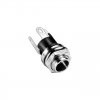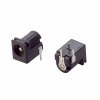Hippogriff
Member
Time for another dumb question...
I wanted to create a thread to ask if I've missed a trick somewhere along the way. I create most of my circuits on verboard that I then glue into place... I then cut the wall wart cables and solder them directly to lines on the strip board - this has never felt good to me. I doubt I should really be doing that.
One time I used a project box and kept the circuit in there. In there, on the roof of the box, I glued a power socket and connected the wall wart's plug directly to that. That felt a bit better.
I've done a bit of searching, Maplin etc., but I've really had no luck so far... and there doesn't seem to be a component I can buy which is a barrel jack socket component with two legs that just slot into the holes that are provided by either a breadboard or (more usefully) some veroboard.
Most of the connectors / sockets I see have these three flat paddles with holes on them... which don't fit into the holes at all. So, I'm guessing, when you use them, they are glued to the board and then wires are attached to the paddles. If I could get hold of a socket component that had little legs that went right into the verboard holes, I could solder my socket to the verboard, and have the wall wart power supplies just connect into it as and when I want.
Does this thing exist or is it all a pipe-dream?
If they do... any pointers would be appreciated.
I wanted to create a thread to ask if I've missed a trick somewhere along the way. I create most of my circuits on verboard that I then glue into place... I then cut the wall wart cables and solder them directly to lines on the strip board - this has never felt good to me. I doubt I should really be doing that.
One time I used a project box and kept the circuit in there. In there, on the roof of the box, I glued a power socket and connected the wall wart's plug directly to that. That felt a bit better.
I've done a bit of searching, Maplin etc., but I've really had no luck so far... and there doesn't seem to be a component I can buy which is a barrel jack socket component with two legs that just slot into the holes that are provided by either a breadboard or (more usefully) some veroboard.
Most of the connectors / sockets I see have these three flat paddles with holes on them... which don't fit into the holes at all. So, I'm guessing, when you use them, they are glued to the board and then wires are attached to the paddles. If I could get hold of a socket component that had little legs that went right into the verboard holes, I could solder my socket to the verboard, and have the wall wart power supplies just connect into it as and when I want.
Does this thing exist or is it all a pipe-dream?
If they do... any pointers would be appreciated.



